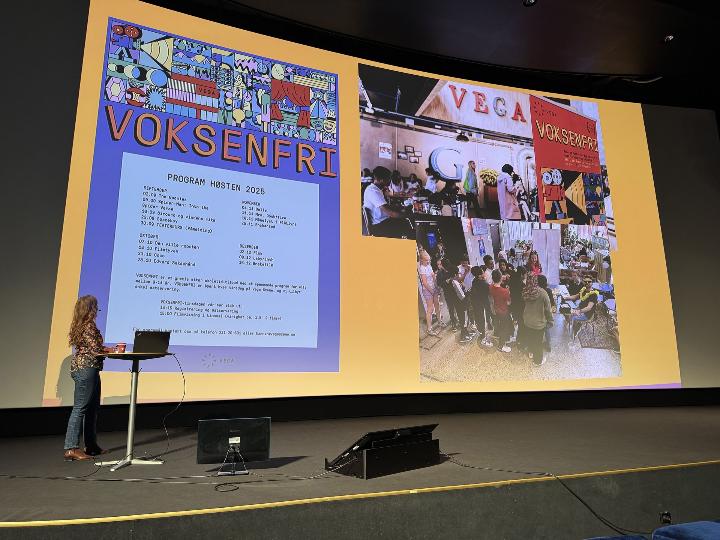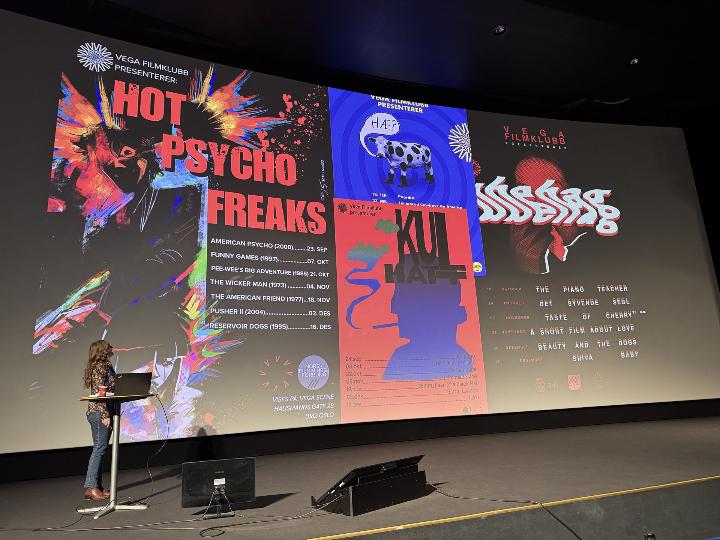At a time when exhibitors worldwide are grappling with how to attract younger audiences away from streaming services and gaming consoles, a cinema and culture centre in Oslo, Norway has quietly developed one of the most comprehensive youth engagement programmes in European exhibition. The presentation by Hannah Hasseløy, Project Leader at Vega Scene, at the Norwegian Cinema Conference 2025 in Kristiansand on 3 November, revealed a sophisticated three-tier approach to building cinema-going habits that other cultural institutions would do well to study. It also showed that young people should not be under-estimated when it comes to developing a taste for sophisticated cinema programmes.
The Economics of Free
Vega Scene's model flies in the face of conventional exhibition economics: all youth programmes are entirely free. No tickets, no concessions revenue, no membership fees. This isn't charity work, however, as much as it’s a long-term investment in audience development that recognises a fundamental truth many exhibitors miss: the barrier to youth engagement isn't just price, it's also relevance.
Since opening in 2018, Vega Scene has built its youth strategy around two seemingly contradictory principles: maximum accessibility coupled with an uncompromising committment to quality. As Hasseløy explained to the Film & Kino conference, the venue deliberately positions itself as an alternative to the sports and gaming activities that dominate young people's leisure time, creating a space for what she candidly described as "the weird kids", i.e. those interested in culture and film who often feel isolated from their peers.

Three Tiers of Engagement
The sophistication of Vega Scene's approach lies in its recognition that youth engagement isn't monolithic. The venue operates three distinct programmes, each calibrated to specific developmental stages and engagement levels:
Voksenfri (Adult-Free) targets 9-12 year-olds with weekly Tuesday screenings that begin with a free meal - a detail that shouldn't be overlooked or under-estimated as a ‘pull’. The meal serves multiple functions: it addresses potential food insecurity, creates a social buffer zone before screenings, and establishes regular staff relationships. The recent Halloween screening of Tim Burton's "Edward Scissorhands" drew 56 children, demonstrating that classic cinema can compete with contemporary entertainment when properly presented.
U-Kultur (Un-Culture) for 13-15 year-olds nearly failed at launch in 2023, with empty auditoriums in its first weeks. The turnaround came through peer marketing – specifically a TikTok campaign run by students from nearby Elvebakken High School. This pivot from institutional to peer-driven marketing offers a crucial lesson for exhibitors struggling to reach Gen Z: authenticity trumps reach.
Vega Ung Film (VUF - Vega Young Film) represents the programme's most innovative tier. The 16-25 age group doesn't just attend screenings; they curate and operate Vega's public film club. Members hold formal positions - director, secretary, marketing manager – gaining legitimate workplace experience while programming for multigenerational audiences. The result? Youth-programmed screenings regularly sell out, with young people comprising the majority of attendees. The films? A programme that would not shame a repertory arthouse cinema: The American Friend, The Seventh Seal, The Piano Teacher, A Short Film About Love. All curated into distinct seasons: Hot Psycho Freak, Ubehag (Discomfort), etc.

The Participation Pyramid
What Vega Scene has constructed is essentially a participation pyramid that moves young people from passive consumption to active creation. This progression from audience to programmer mirrors successful models in other cultural sectors but remains rare in cinema exhibition.
The pyramid's base (Voksenfri) focuses on habit formation and socialisation. The middle tier (U-Kultur) introduces critical thinking and film literacy. The apex (VUF) develops leadership and professional skills. Crucially, movement between tiers is encouraged but not mandated; some children attend Voksenfri purely for the safe after-school environment, never developing a particular film passion, and that's considered a success too.
Scaling the Model
The funding challenges Hasseløy described - particularly Bufdir's sudden withdrawal of support - highlight a persistent problem in youth cultural programming: the mismatch between long-term audience development and short-term funding cycles. Vega Scene now operates on what Hasløy called a "patchwork" of funding sources, a precarious position for such a successful programme.
Yet the model's core elements are replicable without massive investment. The key insights for other exhibitors and cultural institutions are:
- Age segmentation matters: The failed attempt to serve 9-14 year-olds in a single programme demonstrates that youth engagement requires precise targeting.
- Food is programming: The free meal component addresses practical barriers while creating community. It's social infrastructure, not just hospitality.
- Peer leadership works: Young people programming for young people generates authentic engagement that no amount of professional marketing can replicate.
- Quality doesn't mean contemporary: The enthusiasm for "Edward Scissorhands" and classic films suggests young audiences are hungry for curation, not just novelty.
- Employment pathways matter: Several VUF alumni have leveraged their experience into paid positions, validated by Hasseløy serving as their professional reference.

The Long Game
What's most striking about Vega Scene's approach is its patience. This isn't a quick fix for declining youth attendance of cinema; it's a decade-long investment in building cinema culture. The venue is essentially running a loss-leading cultural education programme, betting that children who grow up with weekly or monthly cinema visits will become tomorrow's adult audiences.
In an industry often fixated on opening weekend numbers and quarterly results, Vega Scene's model might seem quixotic. But as traditional audience development strategies falter and the generational shift to home viewing accelerates, Oslo's experiment in radical accessibility and youth empowerment offers something invaluable: proof that young people will choose cinema if cinema chooses them. Oslo might be known for its recent cultural landmarks, such as the Oslo Opera House and the MUNCH Museum, but Vega Scene is no less of a cultural achievement.
The question isn't whether other venues can afford to replicate Vega Scene's model. Given the existential challenges facing theatrical exhibition, the question is whether they can afford not to. As Hasseløy concluded her presentation: "Make room for children and young people in cinema because they will if they get the chance."
The evidence from Oslo suggests she's right.
Building Tomorrow's Cinema Audience: How Oslo's Vega Scene Cracked the Youth Engagement Code